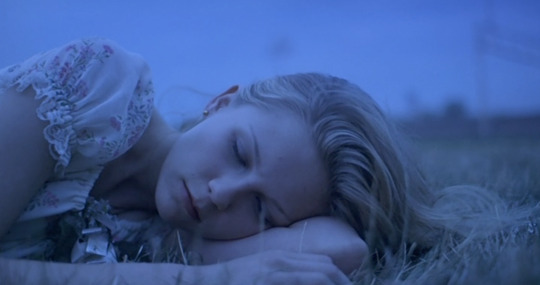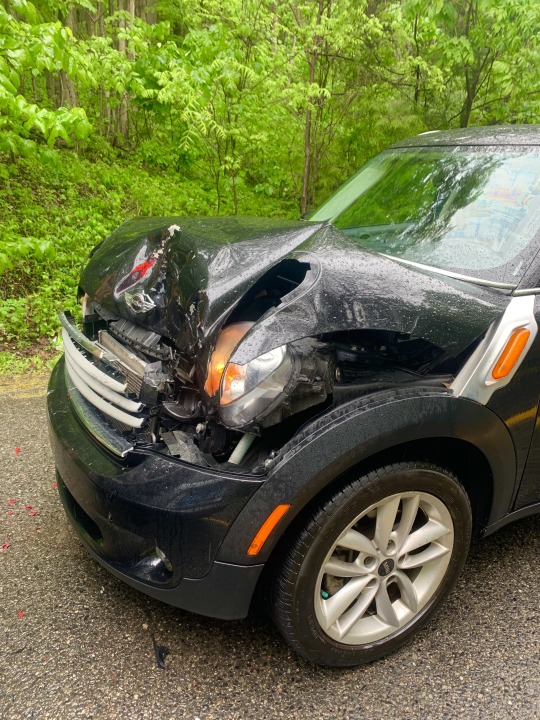Don't wanna be here? Send us removal request.
Text
The Virgin Suicides and the Male Gaze
The term ‘male gaze’ was first established as a term to describe the depiction of female characters in film. The idea was coined by British feminist film theorist, Laura Mulvey in her 1973 essay “Visual Pleasure and Narrative Cinema”. In this essay, Laura Mulvey explains that mainstream media objectifies women and often shows women through the heterosexual white men’s lens and sees them as a secondary non-active characters. The male gaze has been present since the beginning of cinema. It can be noticed as a heterosexual male or even a patriarchal society as a whole watching, possessing, and conquering female characters in order to further their goals or them themselves as a character. A film that is made and shown through a male gaze lens is the film The Virgin Suicides (1999), Sofia Coppola’s directorial debut. Virgin Suicides follows the retelling of the events leading up to the joint suicide of the Lisbon sisters one year in the 70s. The story is told decades later through the perspective of a group of neighbourhood boys who were acquainted and fascinated by the sisters. Using Laura Mulvey’s concept ideas of visual pleasure and the depiction of women in cinema, this paper will examine the film The Virgin Suicides, and how the narrator’s actions throughout the film support the idea of the male gaze.
In the opening scene of the film The Virgin Suicides, the viewer is greeted with multiple establishing shots. Setting the scene of the town, what decade it takes place in, and the time of year. The viewer is then met with the shot of Cecilia Lisbon unconscious in the tub after her first suicide attempt. The viewer is introduced to the narrator of the story, once he says, “Cecilia was the first to go.” Immediately, the audience gets the impression that the rest of the Lisbon sisters will eventually meet their fate by the end of the film as well, but leaves the question why? And the assumption that the narrator will have the answer. The narrator then explains that the neighbourhood’s demise occurred after the Lisbon sister's suicides and that the people of the neighbourhood could feel their energy still surrounding them. We then see the faces of our storytellers as they watch the Lisbon sisters exit their car and we are finally introduced to the enigma of the film. The viewer is given a freeze-frame close-up of each sister and with their name appearing beside them. This type of editing gives the viewer the idea that these sisters seem to stop time for the narrators. They are called beautiful creatures and it appears as though the narrator wants us to view these characters the same way and look at them as though they are objects. In Laura Mulvey’s reading, she states, “Playing on the tension between film as controlling the dimension of time (editing, narrative) and film as controlling the dimension of space (changes in distance, editing), cinematic codes create a gaze, a world, and an object, thereby producing an illusion cut to the measure of desire.” (Mulvey 67). The opening scene supports this idea because not merely three minutes into this film the audience is shown the Lisbon sisters as ‘beautiful creatures’ / mysterious characters that we just have to know the story of. The freeze-frame shots that take place also support the idea of the dimension of time being controlled by the female characters’ beauty.

In the scene where the boys are reading Cecilia's diary entries to one another, the boys believe this is the point in time where they are actually ‘getting to know’ the Lisbon sisters. The scene cuts between the boys reading the entries and scenes of the Lisbon sisters and what the boys believe the entries would appear like in real life but are in reality just daydreams. The fade-in and outs between the shots give a soft daydream-like impression. The colours existing in the shot are warm. In Chapter 4, of The Film Experience: An Introduction by Timothy Corrigan and Patricia White, they discuss the impact colour can have on a scene, “Depending on genre or desired effect, a film may use realistic or unrealistic palettes, create mood through a monochromatic color scheme, or add tension through dramatic oppositions in color.” (Corrigan and White 138). The cinematography invokes a summery nostalgic feeling with the shots in this scene consisting of warm, saturated tones, with golden highlights and lens flares. This scene also consists of intense close-ups of each sister orchestrating an intimate moment between the audience and Lisbon sisters. Corrigan and White also mention the meaning behind what close-ups can mean in a scene, writing, “Close-ups (abbreviated CU in scripts and notes) are fragments that show details of a person or an object, such as the face or hands or a flowerpot on a windowsill, perhaps indicating nuances of the character’s feelings or thoughts or suggesting the special significance of the object.” (Corrigan and White 132). With this in mind, it is almost as if this is the boys/ narrator's way of trying to get the audience to see the Lisbon sisters through their eyes. Desirable, mystic, and beautiful. These camera movements and shots are all executed in a certain way to highlight the sister's femininity and eroticness. Based on the cinematography alone, their presence represents feelings of nostalgia, fear, and desire for the boys and this is a clear example of what Mulvey calls the female spectacle.


A quote that stands out from Mulvey’s essay is, “In their traditional exhibitionist role women are simultaneously looked at and displayed, with their appearance coded for strong visual and erotic impact so that they can be said to connote to-be-looked-at-ness.” (Mulvey 62), meaning that in films women are most likely used to stimulate and pleasure the men that are watching them. This quote ties in well with Virgin Suicides because the entirety of the film is about the voyeurism the boys experienced while watching the Lisbon girls. Voyeurism can be defined as the sexual pleasure one receives from watching or looking at someone, especially if the person they are watching is participating in sexual acts. The boys watched the Lisbon sister's every move and were consistently updating each other about them. They could recall what day they wore specific tops, noticed the house deteriorating, and even watched Lux have sex through a telescope. This enforces Muley’s idea of the active/male and passive/female. The Lisbon sisters are just simply living their lives and are not seeking to be watched by the boys, but the boys continuously go out of their way to do so. Cinematography and colour come into play again over here. When the boys were reading Cecilia’s diary and daydreaming about the sisters the colour scheme as mentioned before was warm and cozy. While when they are watching Lux have sex with what they believe is random men through binoculars and telescopes, the colours are cold, blues, and dark tones. This same colour scheme is always present when the narrator retells events of Lux being romantic with Trip and other men, almost as if it breaks the idea of innocence that the boys have of the sisters.




To conclude, the male gaze has been extremely prevalent in films since the beginning of cinema and is still present in films today. The male gaze limits and defines women in demeaning and harmful ways, it projects women as meaningless characters without the presence of male characters. On a large scale, the male gaze elevates the white heterosexual male’s experience at the expense of women as it maintains the patriarchal structure. Sofia Coppola highlights the male gaze very well in her film through the elements of cinematography and editing. More specifically through colour play and her intense close-up shots. The Virgin Suicides is the perfect example of events being told and shown through a male lens.

References
Corrigan, Timothy and Patricia White. The Film Experience: An Introduction (6th Edition). Boston: Bedford/St. Martin’s Press, 2021.
Mulvey, Laura. “Visual Pleasure and Narrative Cinema.” Visual and Other Pleasures, 1989, pp. 14–26., https://doi.org/10.1007/978-1-349-19798-9_3.
2 notes
·
View notes
Text
i totalled my first car and got hit in my rental
unfortunately yes, this actually happened
its a gloomy rainy day, you're driving and sobbing uncontrollably to bulletproof... I wish I was by radiohead. you're in autopilot, the destination is work and you're taking your normal route cruising down reesor road. the grey skies and wet roads are giving very much ... the giver. you know this road, you could drive it with your eyes closed, you're going around the first sharp turn expecting there to be nobody there. there's never anyone there. why are five cars stopped immediately after this turn. oh shit, you have to break. bro break harder. yeah no, you're not gonna break in time. no chance.
you end up completely rear ending an old CR-V. now one thing no one ever talks about when you get in an accident... is that the music still keeps playing. realization sits in... you've been in an accident but thom yorke's shrill voice is still fucking blaring through your shitty mini cooper's sound system.
the CR-V has minor damages, but your cars totalled. there's no saving it. the people you hit are young, super nice and understanding. you're crying even harder now, apologizing over and over and over again. you hit them and they're consoling you. get a grip.
you do what you gotta do when you're in an accident. exchange info, head to the collision centre, watch your first car get towed away. collision centres already suck and they suck even more when you're at fault. the workers are grilling you hard, they know your insurance bout to skyrocket. you might still be teary eyed, nose running under your mask.
...
its been a couple of days since you totalled your car. you’re driving a rental, its nice, its got CarPlay, its red, and its got that new car smell. you’re figuring out how you’re going to come up with the money for a new car that's not another piece of shit.
you take a drive to north york with your bestie to try out a bakery and you parallel park on the road. already a miracle in itself. you come out of the bakery and the front end of your rental car has got some damage. just when it can't get any worse. immediately your mind returns to when you were signing the waiver for the rental car and declining the insurance that covers any damage that happens to car thinking “oh I could never possibly get into an accident with this rental, the probability of that happening is extremely low.” ... not for you babe. not for you.
just like that $500 is gone. and you still don't have a car to get you anywhere. you eventually find a really nice car, a 2015 volkswagen golf, a huge upgrade from your mini cooper. you love the car. after all the costs between the tow trucks, insurance, rental deductible and down payment for your new car go through, the 3000 dollars you worked so hard to save in order to move out turned into a lousy $700.
but at least you’re still alive!
r.i.p bullet imy </3

0 notes








